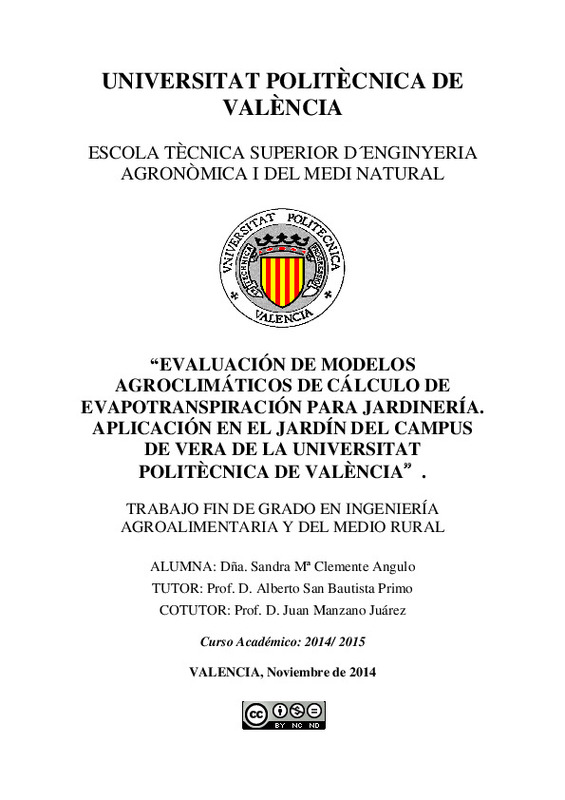|
Resumen:
|
[EN] Evapotranspiration (ET) is the combination of two separate processes by which water is lost
through evaporation ground surface, and moreover, by crop transpiration. Evapotranspiration is
usually measured in millimeters ...[+]
[EN] Evapotranspiration (ET) is the combination of two separate processes by which water is lost
through evaporation ground surface, and moreover, by crop transpiration. Evapotranspiration is
usually measured in millimeters (mm) per unit of time and its measurement is vital in arid and
semiarid regions, where it is essential for determining the water needs of crops and thus for the
design and management irrigation systems. The concept of potential evapotranspiration (ETP) was
introduced to express the evaporation power of the atmosphere in a specific location and time of
year, without considering the crop characteristics and the soil factors. Doorenbos and Pruit (1977)
recommend the use of reference evapotranspiration (ET0) as a necessary variable in the calculation
of the water requirements of crops. Factors related to the cultivation and management were
encompassed in the empirical function Kc = ETc / ET0 where ETc
is the crop evapotranspiration.
Currently the Penman-Monteith is the only one method recommended by FAO and ASCE
(American Society of Civil Engineers) to determine ET0 with the climatic parameters of radiation, air
temperature, air humidity and wind speed. But this method has the disadvantage of the large
amount of data required and it is urgent the assessment of simpler methods of calculation the ET0 in
connection with the Penman-Monteith method.
Therefore, the main objective of this work is to evaluate simpler mathematical models for
calculating the evapotranspiration, using as comparison criterion the Penman-Monteith method.
Furthermore, it is intended to obtain a balance of soil moisture from climate variables and
parameters of irrigation in order to establish a coefficient of garden (Kj) relating the ET0 and ETc
.
The study is performed for the period from 2010 to 2013 as from climatic data of
extraterrestrial radiation, temperature, relative humidity and wind speed obtained in the
meteorological observatory of the Polytechnic University of Valencia. ET0 is calculated with climate
data using the following methods: Penman-Monteith (1990), Hargreaves (1975), Hargreaves (1985),
Samani (2000) and Priestley-Taylor (1972). After calculating the ET0 with such methods, using daily
values of climatic variables involved in each method and mean values for each month, are proposed
a number of alternative models with changes in their leading coefficients. Then the new coefficients
are estimated through a recalibration between the values of ET0 Penman-Monteith and climatic
variables involved in each model, using a nonlinear fit for each model studied. Moreover, in this work
we have calculated the moisture balance of garden soil from the Polytechnic University of Valencia as
the difference that occurs between the inputs (precipitation or irrigation) and water outflows
(evapotranspiration, surface runoff and deep percolation); And it has also been measured moisture
content of the soil using FDR probes.
After statistical analysis, it can be said that for the ET0 monthly values best results are
obtained with the method of Hargreaves (1985) with all coefficients recalibrated. However, for daily
values of ET0, the method that works best is the Priestley-Taylor, also recalibrating all the coefficients
of the equation.
Finally, comparing graphically the soil moisture content calculated by the balance of moisture
and the moisture content measured using probes FDR, has been obtained a garden coefficient (Kj)
0,33 which relates the ET0 and ETc
, and it is a value comparable to the results of other studies.
[-]
[ES] Actualmente el método de Penman-Monteith es el único recomendado por la FAO y la ASCE (American Society of Civil Engineers) para determinar la ET0 con parámetros climáticos de radiación, temperatura del aire, humedad ...[+]
[ES] Actualmente el método de Penman-Monteith es el único recomendado por la FAO y la ASCE (American Society of Civil Engineers) para determinar la ET0 con parámetros climáticos de radiación, temperatura del aire, humedad atmosférica y velocidad del viento. Pero dicho método presenta el inconveniente de la gran cantidad de datos requeridos y es urgente la evaluación de métodos más sencillos de cálculo de la ET0 en relación con el método de Penman-Monteith.
Por ello, el principal objetivo de este trabajo es evaluar modelos matemáticos de cálculo de la evapotranspiración más sencillos, utilizando como criterio de comparación la ecuación de Penman-Monteith.
Además, se pretende obtener un balance de humedad en el suelo a partir de variables climáticas y parámetros de riego, con el fin de establecer un coeficiente de jardín (Kj) que relacione la ET0 y la ETc.
El estudio se realiza para el período de años de 2010 a 2013 a partir de los datos climáticos de radiación extraterrestre, temperatura, h
[-]
|







